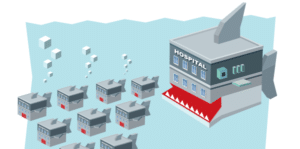 Hospitals continue to fight the trends of declining reimbursements and increasing expenses with a multi-pronged attack. One of the favorite tools of larger health systems that are staving off shrinking margins is hospital consolidation. The idea goes that as more hospitals are brought into the health system, efficiencies can be gained by sending less profitable procedures to lower cost settings and consolidating the highest margin procedures at the flagship hospital(s). With all of the changes going on in health care, one fact will remain the same – hospital consolidation is here to stay.
Hospitals continue to fight the trends of declining reimbursements and increasing expenses with a multi-pronged attack. One of the favorite tools of larger health systems that are staving off shrinking margins is hospital consolidation. The idea goes that as more hospitals are brought into the health system, efficiencies can be gained by sending less profitable procedures to lower cost settings and consolidating the highest margin procedures at the flagship hospital(s). With all of the changes going on in health care, one fact will remain the same – hospital consolidation is here to stay.
One of the operational challenges of growing a health system is making sure that the same standard of care is reached regardless of the setting. This means that the best practices learned from the flagship hospitals need to be carried out at community hospitals and surgery centers that are built or brought into the fold. While simple in theory, this has been a nagging challenge to health systems in practice.
To create a culture of safety, health systems must not only spend the time and money to properly train staff, they must also invest in the right technologies. While staff can be trained in all the safest practices, how can you ensure that staff are following them when no one is watching? One possible solution is to use software for documentation and tracking.
For example, some of the top hospitals in the country use RFID-based tracking and documentation software from Mobile Aspects to ensure Joint Commission standards are consistently met in their tissue, endoscopy and blood operations. Using this software, health systems are able to define their best practices and enforce them using tracking software. Health systems define the workflows that they want their employees to follow, then Mobile Aspects encodes these workflows into the tracking software to ensure a consistent, repeatable process. When protocols are breached, employees are immediately alerted about skipped or incomplete steps for immediate correction. Managers are also sent reports that allow them to identify employees who make repeated errors so that they can be given additional education.
With all of the uncertainty that hospital consolidation brings to both the acquiring health system and the acquired hospital, make it a priority to introduce automation to ensure consistent practices are followed throughout the health system. This will bring you one step closer to a true culture of safety by making sure employees are following best practices every single time.
